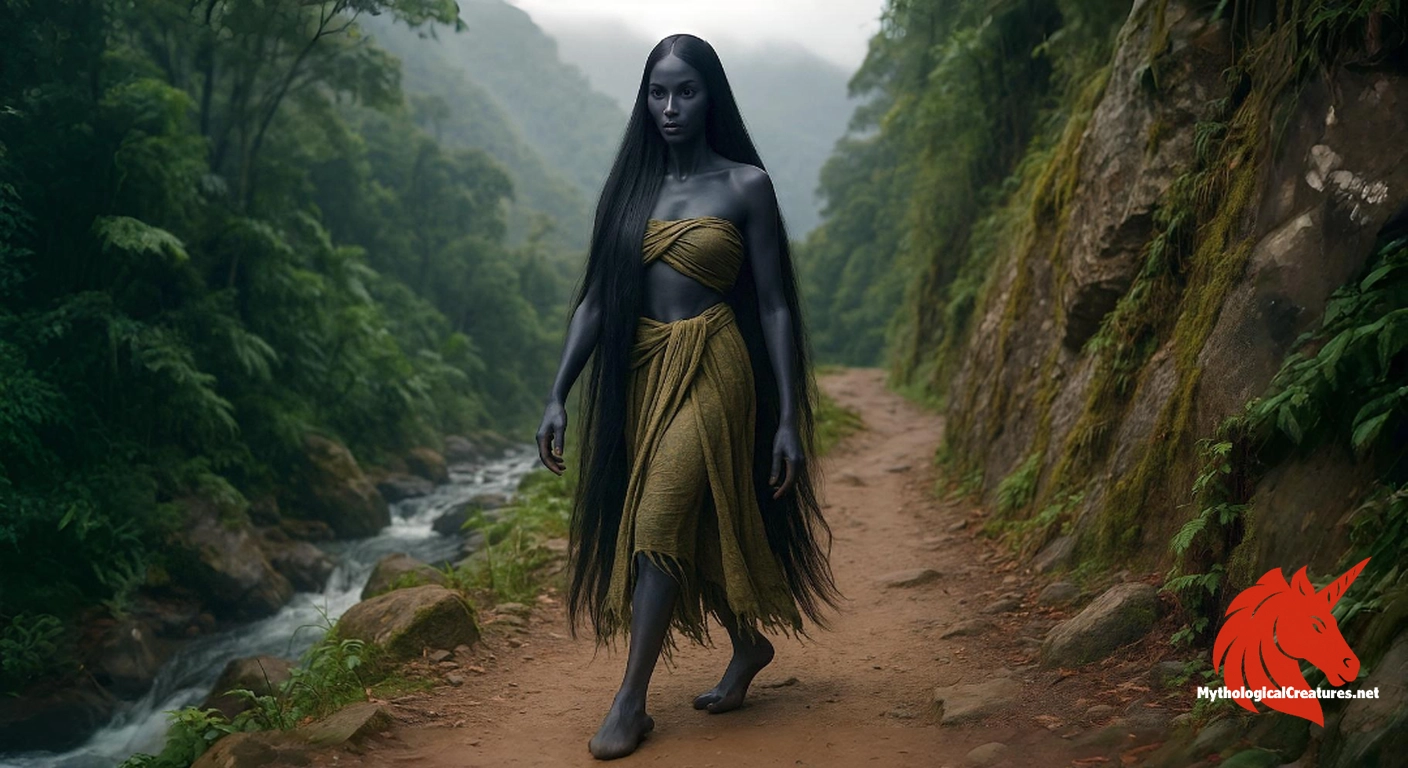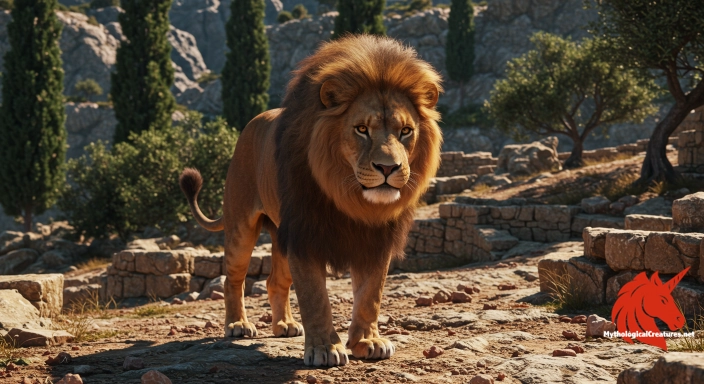Ciguapa: The Ciguapa is a mysterious, seductive figure from Dominican folklore, distinguished by her backward-facing feet and flowing, glossy hair.

Ciguapa
Ciguapa - The Ciguapa symbolizes the mysterious and potentially perilous allure of untamed nature in Dominican culture.
Origins & First Encounters
The ciguapa captivates the imagination as a mysterious figure emerging from the highland legends of the Dominican Republic. Born from rich oral traditions, her story has been passed down through generations, retaining an aura of enchantment that defies time. Her presence is perceived as an intricate blend of beauty and danger, challenging the boundaries between the natural and supernatural. The creature’s origins are interlaced with the cultural heritage of a land shaped by both indigenous and colonial influences. Her tale, though shadowed by the mists of antiquity, continues to resonate with those who dwell in and honour the rugged mountainous landscapes. The ciguapa is depicted as a symbol of both the raw forces of nature and the profound mystery that lies within the human spirit. In the myriad retellings, she appears not just as a myth but as a profound allegory for the wild terrain she inhabits. Local tradition infuses her with a dynamic and multifaceted character that highlights the enduring power of folklore. Her narrative exemplifies how myth weaves together the elements of fear, fascination, and the timeless allure of the unknown. Ultimately, the ciguapa remains a testament to the resilience of cultural legends that bridge the realms of history and mystery.
Source Texts & Tale Variants
The many accounts of the ciguapa have been preserved primarily through the oral narratives of Dominican villagers and travellers alike. Early chroniclers recounted sightings and escapades that vividly portrayed her as a formidable yet alluring presence in mountainous retreats. Folklorists have noted that her myth evolved through diverse retellings, each version adding subtle nuances to her character. Tales gathered from remote communities reveal stories where encounters with the ciguapa evoke a sense of both dread and irresistible temptation. Multiple versions exist that vary in tone—from tragedies of unreciprocated love to cautionary narratives warning of nature’s untamed aspects. The fabric of her story has been strengthened over time by a blend of indigenous lore and the interpretative flair of later storytellers. Documentation in modern anthologies of Caribbean mythology further emphasises the complexity inherent in her legend. These rich, varied sources provide a treasure trove of insights, revealing the interplay between myth, memory, and local identity. The layered narratives serve not only as cultural records but also as vehicles for transmitting deeper truths about human interaction with the wild. In essence, the collected sources regarding the ciguapa form a vibrant mosaic that reflects both historical depth and the evolving nature of folklore.
Form & Powers
The ciguapa is portrayed with an unmistakably human female silhouette, yet her features carry a supernatural twist that renders her otherworldly. Her skin is said to be either a deep, earthy brown or a mysterious dark blue, invoking the colours of the night and the rugged terrain. Flowing down her form is a mane of exceptionally long, smooth hair, which shimmers with an almost liquid gloss. One of her most striking and unusual attributes is her backward facing feet, a detail that mystifies and intrigues those who hear her tale. This distinctive feature not only sets her apart from mortal beings but also symbolises a departure from the natural order. Artists and storytellers alike have frequently accentuated her lithe, flowing movements, suggesting an agility that defies conventional human anatomy. Descriptions often capture her as radiating both delicate beauty and an inherent wildness, blurring the line between elegance and the fierce spirit of the wilderness. The interplay between her luminous hair and enigmatic visage has inspired myriad depictions in both traditional and modern art. Such detailed portrayals emphasise the duality of her character—a creature both beguiling and subtly terrifying. Ultimately, every physical trait of the ciguapa contributes to a larger narrative that celebrates the mysterious intersection of beauty, danger, and the supernatural.
Regional Faces
Across the varied landscapes of the Dominican Republic, regional lore has enriched the ciguapa legend with unique local flavours. In isolated mountain hamlets, she is often revered as a guardian of pristine natural environs, an ethereal protector of the highland wilds. Meanwhile, other communities weave cautionary elements into her story, portraying her as a seductive lure whose beauty masks perilous intentions. In some areas, her image is intermingled with local myths that celebrate the cycles of nature, intertwining her fate with seasonal rituals and agrarian lore. Different regions may accentuate aspects of her character, with some focusing on her sorrowful solitude while others highlight her role as a supernatural enigma. The variation in her depiction reflects the diverse environments—from dense, misty forests to rugged mountain terrains—that have nurtured her myth. Local artists and storytellers frequently adapt her image to resonate with the cultural and environmental context of their communities. These nuances reinforce the idea that her legend is not static but a living narrative that evolves with the region’s traditions. Through regional adaptations, the ciguapa mirrors the unique challenges and hopes of each community, becoming a multifaceted symbol of nature’s unpredictable spirit. This tapestry of regional legends underscores how deeply local identity and environment can shape the portrayal of mythic figures.
Cultural Parallels
When viewed alongside similar mythological beings, the ciguapa emerges as a uniquely captivating figure in the broader tapestry of folklore. Comparable to entities like the Greek sirens or the lamias, she embodies a complex blend of allure and hidden menace that cautions and mesmerises in equal measure. In Latin American traditions, figures such as La Siguanaba bear a resemblance in their elusive qualities and the dual nature of their charm and hazard. These parallel myths often dwell on the ambiguity of feminine mystery, where beauty and danger coexist in a delicate balance. The ciguapa distinguishes herself further through her distinctive, backwards feet—a physical anomaly that serves as a potent emblem of her supernatural origins. Such peculiarities are echoed in other cultural stories where extraordinary features demarcate the boundary between myth and reality. Comparative analysis reveals that, despite differences in appearance and regional context, many of these legends converge on themes of seduction, transformation, and nature’s untameable power. The interplay of these motifs underscores a universal fascination with figures who blur the lines between human and divine. These resonances across cultural boundaries illustrate how myth functions as a shared language of symbolic expression. In this light, the ciguapa not only stands as a cherished figure within Dominican folklore but also as part of a global narrative celebrating the mysterious and the majestic.
Legacy & Modern Evolution
The evolution of the ciguapa legend mirrors the dynamic interplay between tradition and modern reinterpretation. Over time, this enigmatic figure has transcended the confines of rustic mountain tales to secure a place in contemporary artistic and cultural discourse. Early portrayals rendered her as a spectral seductress whose allure was matched only by the warnings embedded in her myth. In recent years, however, many modern artists and writers have reclaimed her narrative, imbuing the ciguapa with symbols of resistance and feminine power. This transformation speaks to a broader shift in how myth is utilised to challenge traditional roles and celebrate the complexities of identity. Contemporary interpretations often position her as an emblem of natural beauty and the enduring spirit of the wild, resonating with audiences seeking deeper connections with heritage. Film, literature, and visual art have all contributed to a renewed interest in her character, each medium reflecting modern sensibilities while honouring ancient roots. The ciguapa’s story, once confined to spoken lore, now plays a vibrant role in academic discussions and cultural exhibitions. Her enduring legacy is a testament to the malleable and timeless nature of myth, capable of continuous reinvention. Ultimately, the evolving portrayal of the ciguapa reinforces how ancient legends can inspire modern creativity and serve as bridges between the past and the present.
Interesting Fact
A striking and unusual attribute of the Ciguapa is her backward-facing feet, which not only mystify those who see her but also serve as a symbolic reminder of her supernatural origins and her role as a deceiver.
Quick Creature Info
Features:
Associations:
Our Mythic Legendary Rating:

Habitat:
Supernatural Powers:
Physical Attributes:
Abilities:
Behavior:
Lore:
Related Creatures, Tales or Lore
- SSiguanaba
- SSiren
- LLamia
References
Discover Another Mythical Legend You May Not Have Heard Of?
Uncover the mysteries of ancient folklore and expand your knowledge of legendary beings from cultures around the world.
Dare to Meet the Lion of Cithaeron....
Curated by the Mythological Creatures Team (rev. May 2025)
